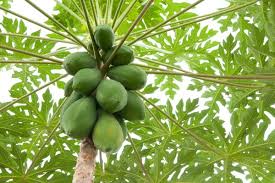Scientific name: Carica papaya
Local names:
English: Pawpaw; Swahili: papaya. Pawpaw is a widely cultivated fruit tree in the tropics and subtropics. General Benefits of Pawpaw Ripe papaya is a favorite breakfast and dessert fruit that is available year-round.
It can be used to make fruit salads, refreshing drinks, jam, jelly, marmalade, candies and crystallized fruits. Green fruits are pickled or cooked as a vegetable.
Suitable Growth Condition
Papaya thrives in warm areas with adequate rainfall and a temperature range of 21-33°C. Its altitude range is similar to that of the banana, from sea level to elevations at which frosts occur (often around 1600 m). However they grow best in areas below 1000 m.
The quality and yield are low at higher altitudes. Frost can kill the plant, and cool and overcast weather delays fruit ripening and depresses fruit quality. Fruit tastes much better when grown during a warm sunny season. Evenly distributed annual rainfall of 1200 mm is sufficient if water conservation practices are employed.
Papaya grows best in light, well-drained soils rich in organic matter with soil pH of 6.0-6.5. It can tolerate any kind of soil provided it is well-drained and not too dry. The roots are very sensitive to water logging and even short periods of flooding can kill the plants.
RELATED: Why Africa offers growing opportunities for agricultural products
PLANTING
Papaya is propagated by seed. To reproduce the desired characteristics it is best to get seeds through controlled pollination. Use of sterilized soil minimizes losses resulting from nematodes and damping-off fungi. Germination takes 2-3 weeks.
Another practice is to sow the seeds in sterilized nursery beds and to prick out at the 2-3-leaf stage, transferring 3-4 seedlings to each container. Seedlings are transplanted about 2 months after sowing when they reach the 3-4-leaf stage or 20 cm height, preferably at the onset of the rainy season.
During transplanting, take care not to disturb the roots. Older seedlings recover poorly after planting out. Papaya needs adequate drainage and is often planted on mounds or ridges. Transplants must be watered regularly until they are established. Field spacing are in the order of 3 x 2 m to 2.50 x 1.60 m, giving densities of 1667 and 2500 plants/ha respectively.
Thinning to one female or one hermaphrodite plant per hill is done when the plants reach the flowering stage. In the absence of hermaphrodite plants, 1 male plant per 25 – 100 female plants is retained as pollinator.
Papaya plants grown from seed produce fruits of different shapes, sizes, colour and even taste. Vegetative propagation of papaya provides a solution to most of these problems. The clone is selected for higher productivity and good quality fruits besides agronomic qualities such as dwarfness for easy harvesting and good resistance to diseases.
Planting holes of 2*2*2 ft are prepared with 1 bucket of compost and is mixed in with the dugout soil and returned around the plant. Firm the soil and water liberally and add mulch around the young plant.
The farmer can choose to grow the crops conventionally or do organic farming.
Inter cropping
Papaya grows best when planted in full sunlight. However, it can be planted as an inter crop under coconut, or as a cash crop between young fruit trees such as mango or citrus. Low growing annual crops such as capsicums, beans, onions and cabbages are suitable good inter crops.
Harvesting
The stage of physiological development at the time of harvest determines the flavor and taste of the ripened fruit. The fruit matures at 9 months after transplanting. The appearance of traces of yellow colour on the fruit indicates that it is ready for harvesting. Fruits harvested early have longer post-harvest life, but give abnormal taste and flavor. The fruits also tend to shrivel and suffer chilling injuries when refrigerated. The fruit is twisted until the stalk snaps off or cut with a sharp knife. Yields per tree vary from 75 to 150 fruits annually, giving 35 to 50 tons of fruit per ha per year. A papaya plantation can be productive for over 10 years but the economical period is only the first 3 to 4 years. It is therefore advisable to renew the plantation every 4 years.
COST AND RETURNS FROM ONE ACRE
Number of seedlings in one acre at a spacing of 6ft*9ft 800-900 plants.
For 800 plants.
| Item | description | Unit cost (800) | Total cost |
| Manure | One bucket per hole | @30 | 24000 |
| Holes | Digging, transport of manure to the hole, mixing and planting | @30 | 24000 |
| Seedlings | Certified | @50 | |
| Fertilizer |
N.P.K C.A.N |
@70 @70 |
800 1500 |
| Pesticides | Entire season | 5000 | |
| Fungicides | Entire season | 5000 | |
| Water | Entire season | 20000 | |
| Management | farm manager, (Weeding, splaying etc) | @7000 for 9 months | 63000 |
| Misleneous | 7000 | ||
| TOTAL COST | 150000 | ||
| Return per year. | |||
|
75 fruits per plant 150 fruits per plant |
With 800 plants With 800 plants |
@30 @30 |
1.8 million 3.6 million |













